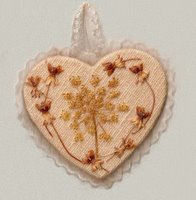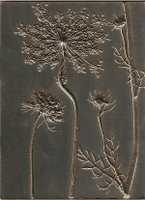Perfect flower for natural crafts
 Queen Anne's lace is blooming across Christian County, and the roadsides near the Bruce Farm on Highway 1716 (right) contain some particularly fine specimens of the flower.
Queen Anne's lace is blooming across Christian County, and the roadsides near the Bruce Farm on Highway 1716 (right) contain some particularly fine specimens of the flower.This "wild carrot" was brought from Europe for use as a medicinal herb by the colonists and was carried west by settlers. Everywhere it was planted, it escaped into the wild. Today, it has spread across the entire United States. It likes dry, sunny places, thrives in poor soil, blooms from early summer through the fall, and seeds itself with wild abandon.
A lady whom I know carried a bouquet of Queen Anne's lace at her wedding. Her wedding day memories include a trip with her husband-to-be to cut her bouquet along the roadside. However, farmers who find an overabundance of the flower in their pastures and fields treat it like any other weed.
The intricate structure of Queen Anne's lace makes it an interesting flower to press. When pressed and dried, it's large enough to make a lacy statement. I have decoupaged arrangements of pressed Queen Anne's lace blossoms to wooden objects with fairly good results.
 The little ornament at right was made by covering a small wooden heart with linen and decoupaging onto it a pressed blossom of Queen Anne's lace and several pressed flowerets from a milkweed blossom. (I apologize that the lace edging is out of focus. This is a scan, not a photo.)
The little ornament at right was made by covering a small wooden heart with linen and decoupaging onto it a pressed blossom of Queen Anne's lace and several pressed flowerets from a milkweed blossom. (I apologize that the lace edging is out of focus. This is a scan, not a photo.)The scan below shows another interesting use of the pressed flower. It is a plaque made by the Hand and Eye Studio of Cosby, Tennessee. Art foil has been pressed over dried flowers and stems of Queen Anne's lace.
I have an old lard press that belonged to my grandfather and I cut and fitted some boards to adapt it to use as a flower press. It will press most anything flatter than a pancake. Most people don't have such an odd piece of equipment though, so it's good that flower presses can be constructed easily with inexpensive materials.
For that matter, a flower press is not necessary. Just place the flowers inside a bed of white paper towels and stack some heavy books on top of them. Or lay the flowers between two white paper towels inside an old catalog or telephone book and weight it down with some heavy books.
When the flowers are dry, use a paintbrush to apply a thin coat of clear-drying glue evenly over the surface where you want to mount the flower. Then carefully place the flower and clean up any excess of glue around the outer edges. Edges can be pressed gently into place with a toothpick or popsickle stick. A weight may help the flower to adhere. A sheet of waxed paper or plastic wrap over the flower should prevent it from being glued to the weight.

2 comments:
What beautiful images! I've always been a fan of Queen Anne's Lace myself, having read a story about the origin of the name when I was a little girl. I notice it all over the place down here, too.
Thanks, too, for the info about flower presses. I've never tried to do that, but now that I have flowers I grow in my garden and take sight-seeing trips through the countryside every now and then, I've been interested in exploring ways to record, somehow, the beauty I find in these places. A flower press may be just what I need!
Have a lovely day! Looks kind of stormy down this way.
WIP
Pressing flowers is lots of fun, and the fact that it's such an old-fashioned hobby makes it interesting also. There's no end to the creative things you can do with the pressings, but one nice thing is to make a homemade greeting card and send it to someone you love. :)
Post a Comment